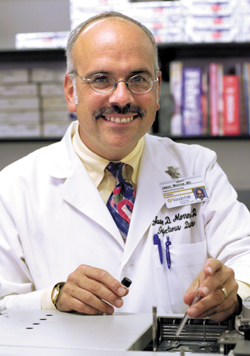
Dr. Jason Morrow is leading the study at Vanderbilt. (photo by Dana Johnson)
Study: young women need more vitamin C
Healthy young women need more vitamin C than currently recommended, according to researchers at Vanderbilt University Medical Center and the National Institutes of Health. The new study, published last week in the Proceedings of the National Academy of Sciences, suggests raising the Recommended Dietary Allowance (RDA) of vitamin C for women from 75 to 90 milligrams daily.
The study is the first to evaluate the relationship between vitamin C dose and concentrations in healthy young women, said Dr. Jason D. Morrow, F. Tremaine Billings Professor of Medicine and Pharmacology. The existing RDA of vitamin C for women is based on data from men – the case for most vitamin dose recommendations, he added.
“This study specifically focused on the effects of vitamin C in women, and how much of the vitamin women ought to consume,” Morrow said.
Morrow and colleagues are not suggesting that women need to take vitamin supplements to meet an increased RDA for vitamin C. Eating a variety of fruits and vegetables – five or more servings daily – satisfies the daily vitamin C requirement for both women and men and offers additional disease-preventing benefits.
Fifteen women, aged 19 to 27, participated in the study. An initial “wash-out” period, during which the women ate a diet that depleted their vitamin C stores, was followed by increasing vitamin C doses and careful measurements of blood and tissue vitamin C concentrations.
The investigators also evaluated vitamin C’s anti-oxidant action by measuring the levels of isoprostanes, molecules produced in the body by oxidant stress – the damage to cells and tissues caused by free radicals and other reactive molecules. Isoprostanes, discovered at Vanderbilt in 1990 by Morrow and Dr. L. Jackson Roberts II, professor of Pharmacology and Medicine, are considered “the best existing measure of oxidant stress in vivo,” Morrow said.
The investigators found that even “mega-doses” of vitamin C had no effect on isoprostane levels. The findings do not rule out the possibility that vitamin C works as an anti-oxidant in other patient populations, for example the elderly or smokers, Morrow pointed out. But in healthy young women, “we could not find a benefit from vitamin C on oxidant stress,” he said.
“Vitamin C has been touted as an anti-oxidant and as a remedy for everything. Overall though, its ability to prevent diseases other than scurvy is questionable.”
Studies of other anti-oxidants, including vitamin E, carotenoids like beta-carotene, and selenium are underway. Early results suggest that vitamin E does reduce isoprostane formation and oxidant stress, Morrow said.
“The effects of vitamins and other supplements on oxidant stress, and the appropriate dosages to achieve those effects, have never been defined,” he said.
Morrow’s colleagues at the National Institute of Diabetes and Digestive and Kidney Diseases are Mark Levine, Yaohui Wang, and Sebastian Padayatty. The studies were supported by the NIH and by a Burroughs Wellcome Clinical Scientist Award in Translational Research to Morrow.













